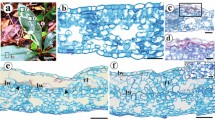Abstract
Analysis ofChelone glabra (Scrophulariaceae) by gas chromatography showed that leaves of this plant contained primarily the iridoid glycoside catalpol, and in a few individuals some aucubin was also detected. There was no difference in the iridoid glycoside content of damaged compared to undamaged plants, nor was there a difference between plants collected from a population in Leverett, Massachusetts, and those from plants in an experimental garden in Cambridge, Massachusetts. Larvae and prepupae of the sawfly,Tenthredo grandis (Tenthredinidae) contained catalpol sequestered from the larval host plant. The exuvia also contained catalpol, whereas the frass contained only aucubin. These results indicate that larvae of this sawfly selectively sequester catalpol, eliminating the aucubin in the frass.
Similar content being viewed by others
References
Belofsky, G., Bowers, M.D., Janzen, S., andStermitz, F.R. 1989. Iridoid glycosides ofAureolaria flava and their sequestration byEuphydryas phaeton butterflies.Phytochemistry 28:1601–1604.
Bjorkman, C., andLarsson, S. 1991. Pine sawfly defence and variation in host plant resin acids: A trade-off with growth.Ecol. Entomol. 16:283–289.
Boeve, J., andPasteels, J.M. 1985. Modes of defense in nematine sawfly larvae: Efficiency against ants and birds.J. Chem. Ecol. 11:1019–1036.
Bowers, M.D. 1980. Unpalatability as a defense strategy ofEuphydryas phaeton (Lepidoptera: Nymphalidae).Evolution 34:586–600.
Bowers, M.D. 1981. Unpalatability as a defense strategy of western checkerspot butterflies (Euphydryas, Nymphalidae).Evolution 35:367–375.
Bowers, M.D. 1988. Chemistry and coevolution: Iridoid glycosides, plants and insects, pp. 133–165,in K. Spencer (ed.). Chemistry and Coevolution. Academic Press, New York.
Bowers, M.D. 1991. Iridoid glycosides, pp. 297–325,in G. Rosenthal and M. Berenbaum (eds.). Herbivores: Their Interaction with Secondary Plant Metabolites, Vol. 1., 2nd ed. Academic Press, San Diego, California.
Bowers, M.D. 1992. The evolution of Unpalatability and the cost of chemical defense in insects, pp. 216–244,in B. Roitberg and M. Isman (eds.). Insect Chemical Ecology: An Evolutionary Approach, Chapman and Hall, New York.
Bowers, M.D., andCollinge, S.K. 1992. Fate of iridoid glycosides in different life stages of the buckeye,Junonia coenia (Lepidoptera: Nymphalidae).J. Chem. Ecol. 18:817–831.
Bowers, M.D., andFarley, S.D. 1990. The behaviour of gray jays (Perisoreus canadensis) toward palatable and unpalatable Lepidoptera.Anim. Behav. 39:699–705.
Bowers, M.D., andStamp, N.E. 1993. Effects of herbivory by specialist and generalist caterpillars on host plant chemistry, biomass and sexual reproduction.Ecology. In press.
Bowers, M.D., Stamp, N.E., andCollinge, S.K. 1992. Early stage of host range expansion by a specialist herbivore,Euphydryas phaeton (Nymphalidae).Ecology 73:526–536.
Brower, L.P., Ryerson, W.N., Coppinger, L.L., andGlazier, S.C. 1968. Ecological chemistry and the palatability spectrum.Science 161:1349–1351.
Brower, L.P., Pough, F.H., andMeck, H.R. 1970. Theoretical investigations of automimicry. I. Single trial learning.Proc. Natl. Acad. Sci. U.S.A. 66:1059–1066.
Damtoft, S., Jensen, S.R., andNielsen, B.J. 1983. The biosynthesis of iridoid glucosides from 8-epi-deoxyloganic acid.Biochem. Soc. Trans. 11:594–595.
Eisner, T., Johnessee, J.S., Carrel, J., Hendry, L.B., andMeinwald, J. 1974. Defensive use by an insect of a plant resin.Science 184:966–969.
Gardner, D.R., andStermitz, F.R. 1988. Hostplant utilization and iridoid glycoside sequestration byEuphydryas anicia individuals and populations.J. Chem. Ecol. 14:2147–2168.
Jensen, S.R. 1991. Plant iridoids, their biosynthesis and distribution in angiosperms, pp. 133–158,in J.B. Harborne and F.A. Thomas-Barberan (eds.). Ecological Chemistry and Biochemistry of Plant Terpenoids. Oxford University Press, New York.
Klockars, G.K.,Bowers, M.D., andCooney, B.F. 1993. Leaf variation in iridoid glycoside content ofPlantago lanceolata (Plantainaceae) and oviposition preference of the buckeye,Junonia coenia (Nymphalidae).Chemoecology. In press.
Larsson, S., Bjorkman, C., andGref, R. 1986. Responses ofNeodiprion sertifer (Hym., Diprionidae) larvae to variation in needle resin acid concentration in Scots pine.Oecologia 70:77–84.
Morrow, P.A., Bellas, T.E., andEisner, T. 1976. Eucalyptus oils in the defensive oral discharge of Australian sawfly larvae (Hymenoptera: Pergidae).Oecologia 24:193–206.
Nishio, S. 1980. The fates and adaptive significance of cardenolides sequestered by larvae ofDanaus plexippus (L.) andCycnia inopinatus (Hy. Edwards). PhD dissertation. University of Georgia. University Microfilms.
Prop, N. 1960. Protection against birds and parasites in some species of tenthredinid larvae.Arch. Neerland. de Zool. 13:380–447.
Rimpler, 1991. Sequestration of iridoid glycosides by insects, pp. 314–330,in J.B. Harborne and F.A. Thomas-Barberan (eds.). Ecological Chemistry and Biochemistry of Plant Terpenoids. Oxford University Press, New York.
Stamp, N.E. 1984. Effect of defoliation by checkerspot caterpillars (Euphydryas phaeton) and sawfly larvae (Macrophya nigra andTenthredo grandis) on their host plants (Chelone spp.).Oecologia 63:275–280.
Tallamy, D., andRaupp, M.J. 1991. Phytochemical Induction by Herbivores. John Wiley & Sons, New York.
Waterman, P.G. andMole, S. 1989. Extrinsic factors influencing production of secondary metabolites in plants, pp. 107–134,in E.A. Bernays (ed.). Insect-Plant Interactions, Vol. 1. CRC Press, Boca Raton, Florida.
Author information
Authors and Affiliations
Rights and permissions
About this article
Cite this article
Bowers, M.D., Boockvar, K. & Collinge, S.K. Iridoid glycosides ofChelone glabra (Scrophulariaceae) and their sequestration by larvae of a sawfly,Tenthredo grandis (Tenthredinidae). J Chem Ecol 19, 815–823 (1993). https://doi.org/10.1007/BF00985011
Received:
Accepted:
Issue Date:
DOI: https://doi.org/10.1007/BF00985011




